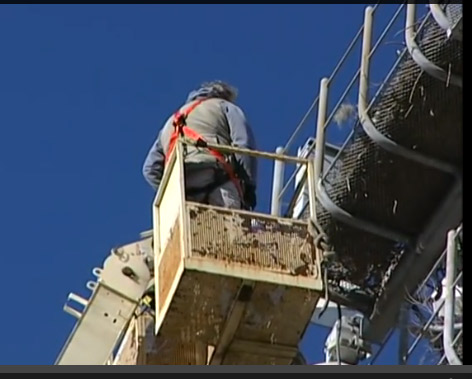[/av_textblock] [av_textblock size=” font_color=” color=” custom_class=”] By JILL MCNEAL
6 News Anchor/Reporter
February 5, 2011
PIGEON FORGE (WATE) – It’s spring training time for major league baseball teams in Florida.
The Baltimore Orioles play at Ed Smith Stadium in Sarasota. But earlier this winter, the stadium was home to a different kind of bird.
It was a windy day in mid-December when the American Eagle Foundation from Pigeon Forge arrived in Florida to help rescue two Bald Eagle eggs from a new nest in a light tower high above the stadium.
“What if a baseball got knocked in there and cracked an egg? What if it was a baby that got hit by a baseball or a youngster that was learning to fly for the first time and landed in the ball field or in a parking lot with a lot of activity?” said foundation President Al Cecere.
So with a special permit from the U.S. Fish and Wildlife Service, he and his team loaded their precious cargo into a special incubator in their RV.
The trip back to Tennessee was long and nerve-racking.
“I had to basically stack a lot of pillows, several layers of really soft pillows, underneath the incubator, and then, if I could feel a bump, I would lift up on the incubator just slightly to take a little bit of the shock away from the incubator and the eggs,” Cecere explained.
Once they made it safely home to Pigeon Forge, the rescue turned into a waiting game until late on December 29.
“I had one staff member here,” Cecere said. “He called me immediately when he saw the eaglet had pipped another hole through the egg, a little bit bigger hole, and I rushed here like a dad would to the hospital if his wife was having a baby and I got here just in time to see the eaglet just out of the egg shell.”
The other egg never hatched. “The second one was not viable, probably not fertile,” Cecere said.
Now came the hard part: raising the eaglet without any human contact. “We want the eagles to be as wild as possible. The first time we fed the baby, we had camouflage clothing on and used the eagle puppet,” he said.
That’s right, workers use an eagle hand puppet poking through a camouflage sheet to give the eaglet its daily meal of raw trout and quail pieces.
“We’re just very careful so the eagle will never, ever associate food with the human figure or voice,” Cecere said.
And just to make sure, the eaglet even got a new neighbor.
“We have an eagle named Oceola, which was the very first eagle our foundation acquired many, many years ago. It’s a one-winged eagle that was shot in Arkansas. She’s very calm, so we put her on a perch and put a Plexiglas window between the baby and the adult so that the baby could see that bird all day long and hopefully get the idea that that’s what its parents would look like,” Cecere explained.
It seems to be working. The eaglet is eating more every day and growing so fast, it will soon be placed in an artificial nesting tower on Douglas Lake in Dandridge.
“We want to get it away from our center and get it where it can actually start observing the wild and hearing what it needs to hear in the wild and look over that lake because that’s where it’s going to learn to fly.”
Back at the Florida ballpark, the Bald Eagle nest has been covered up, hopefully sending the parents back to their old, safer roost on a nearby cell phone tower.
“It’s early enough in the nesting season where they could still double clutch, or lay another set of eggs,” Cecere said.
The eaglet is scheduled for release in mid-March.
It will be fitted with a radio transmitter so the foundation can monitor its progress in the area for the first few days. It will also have a leg band and a colored wing tag for identification in other states.
[/av_textblock]

